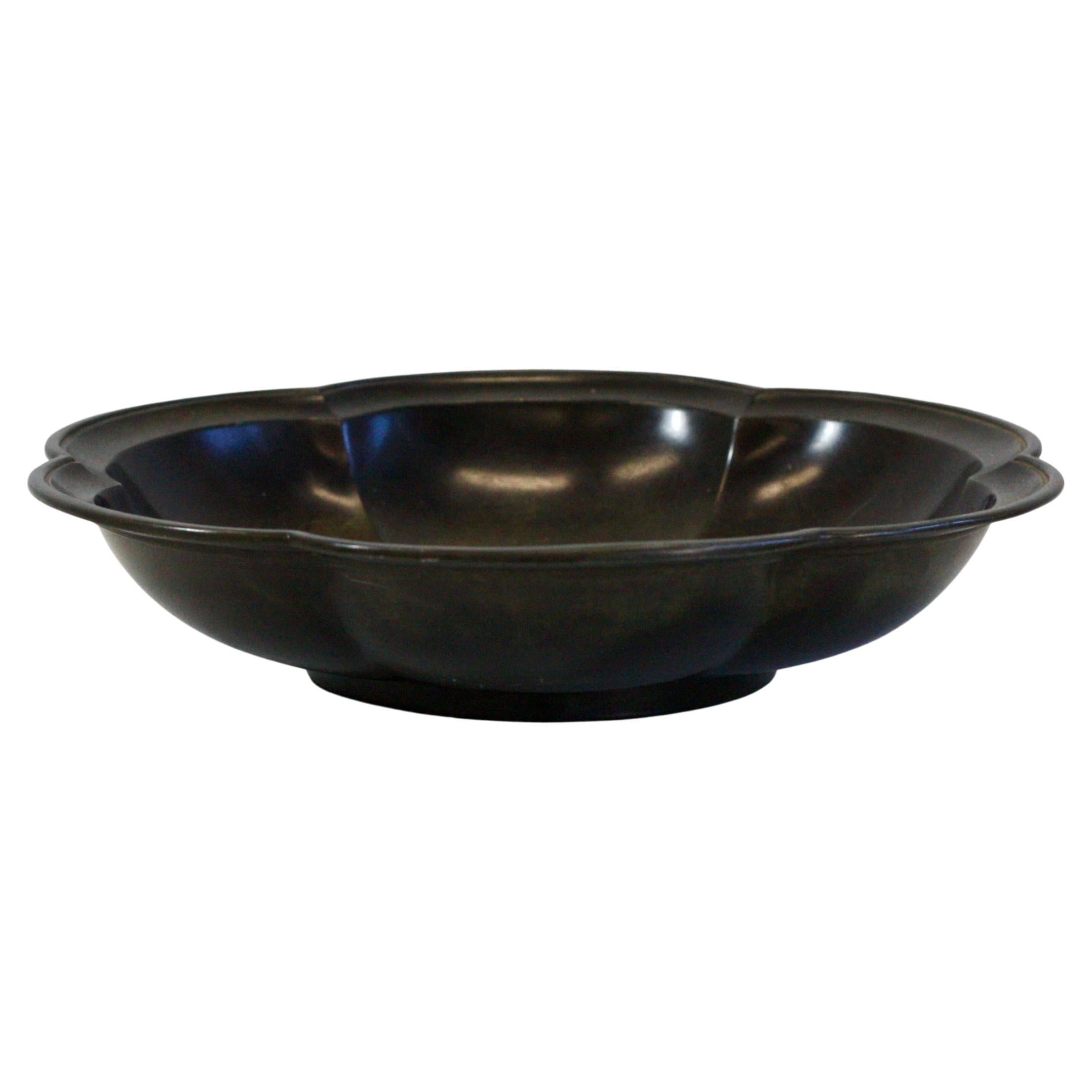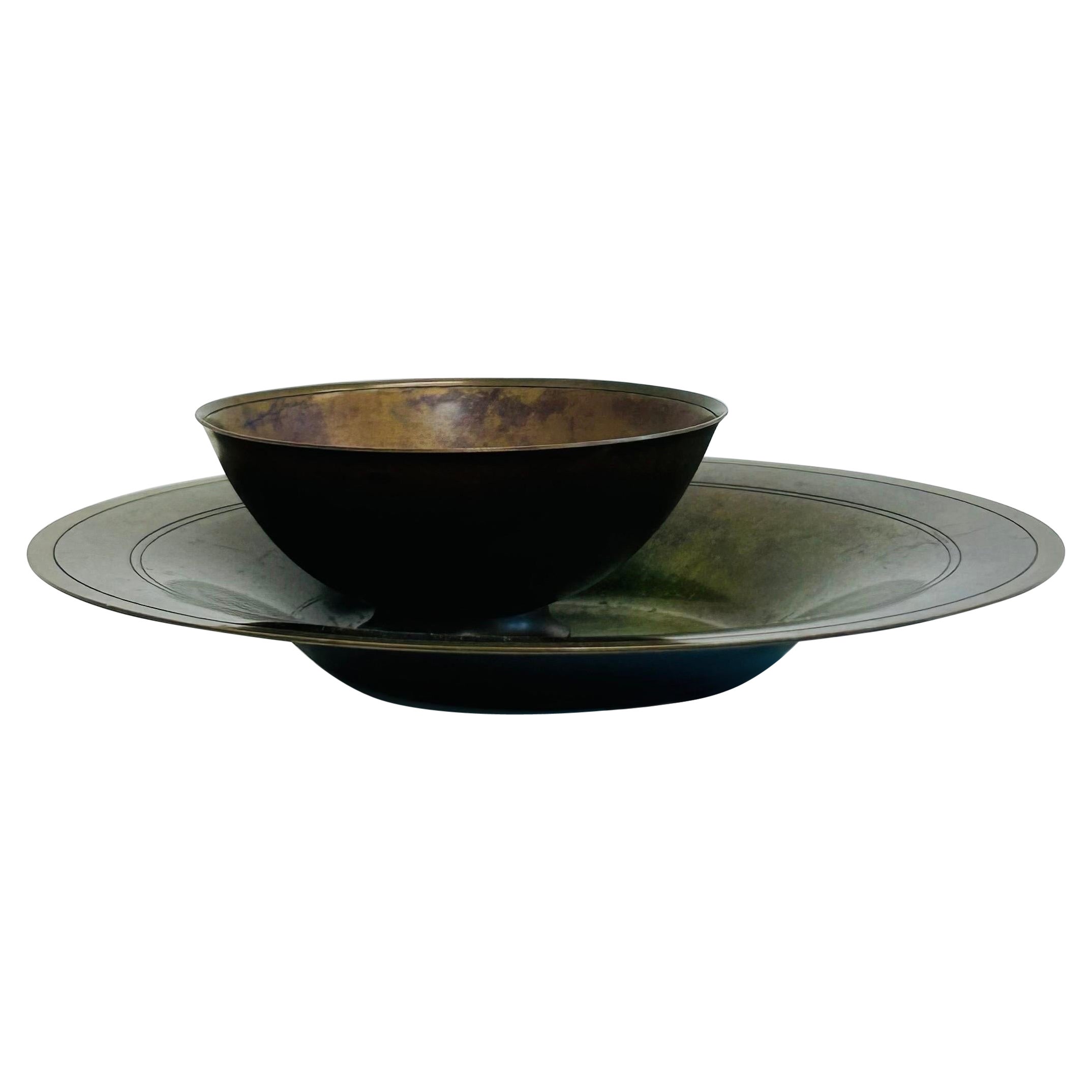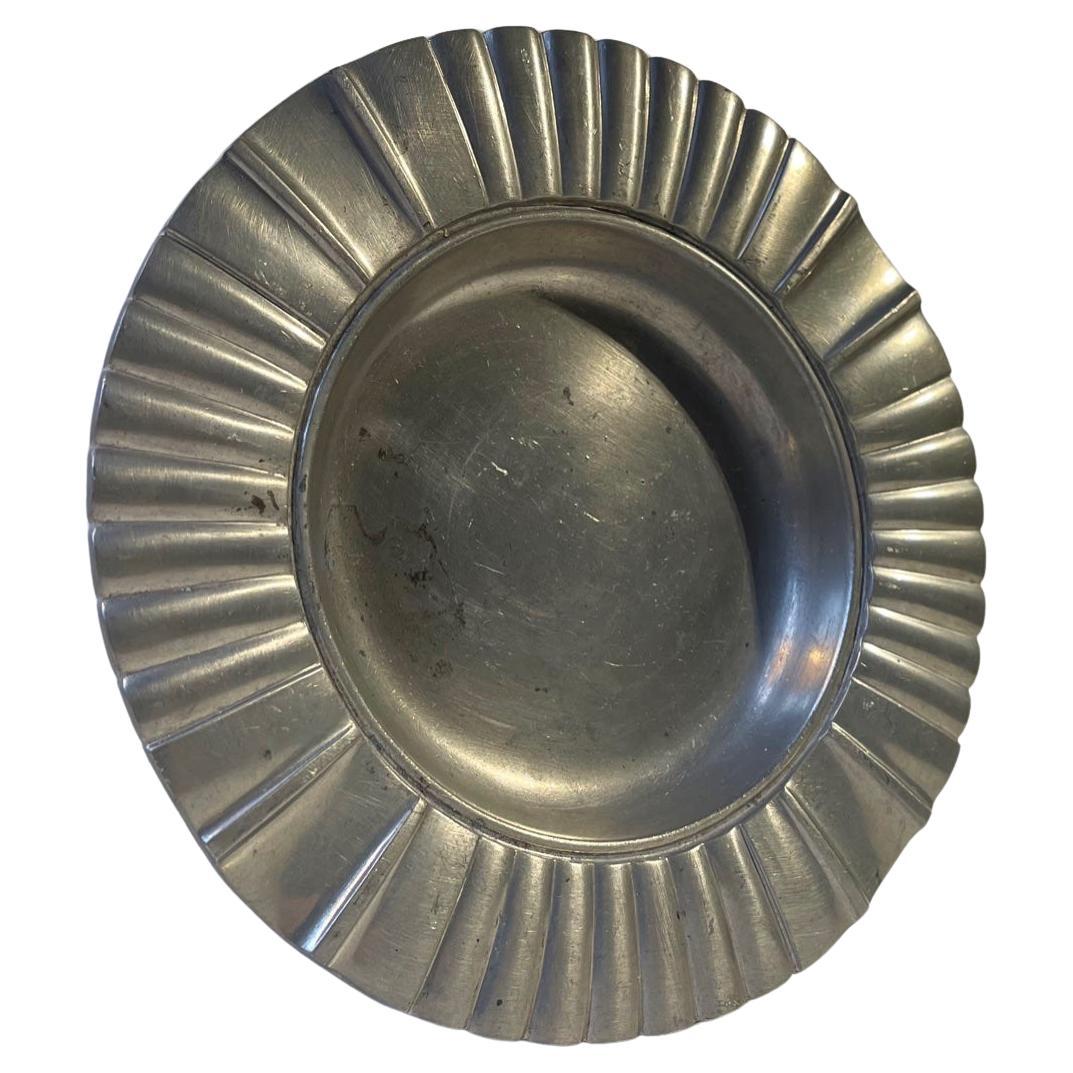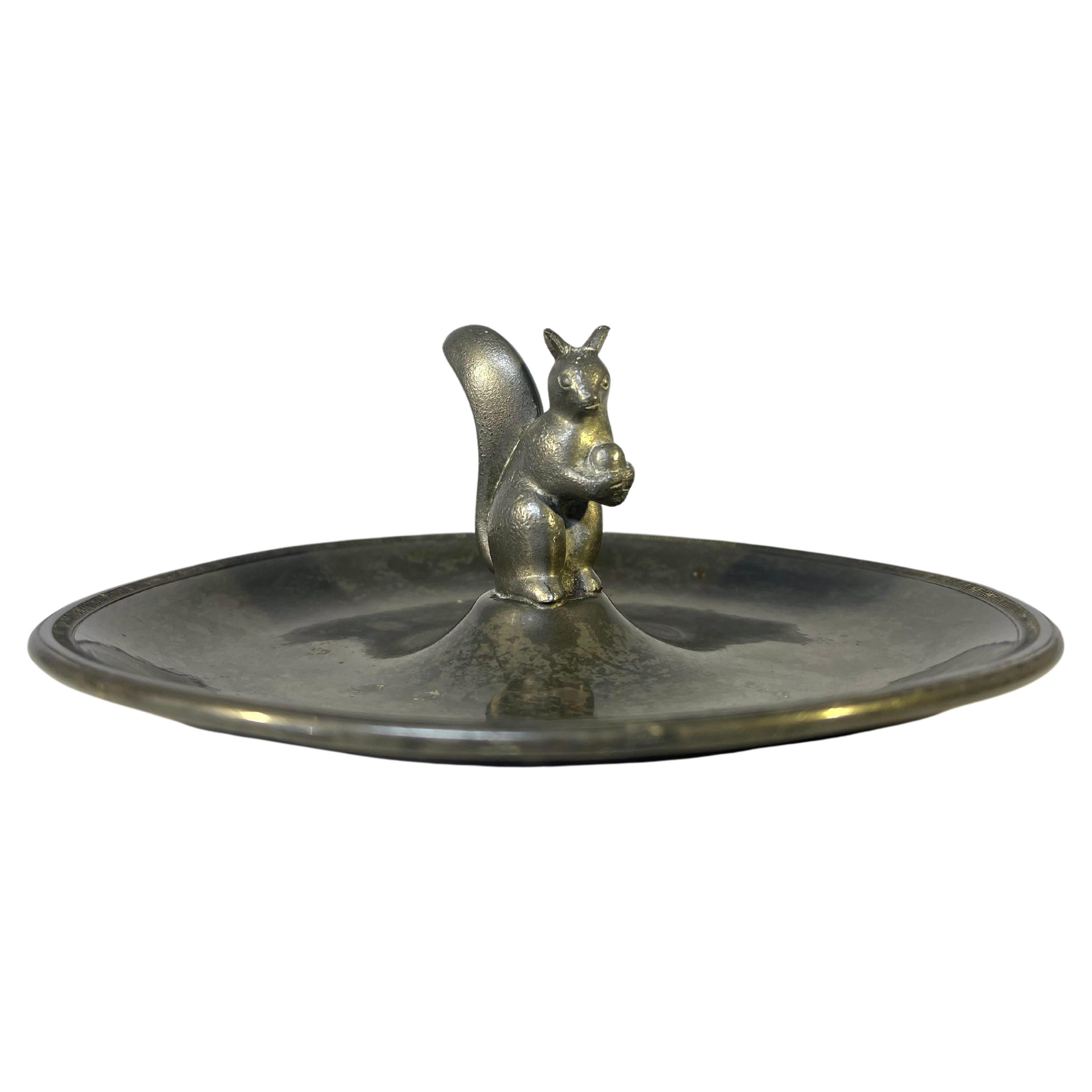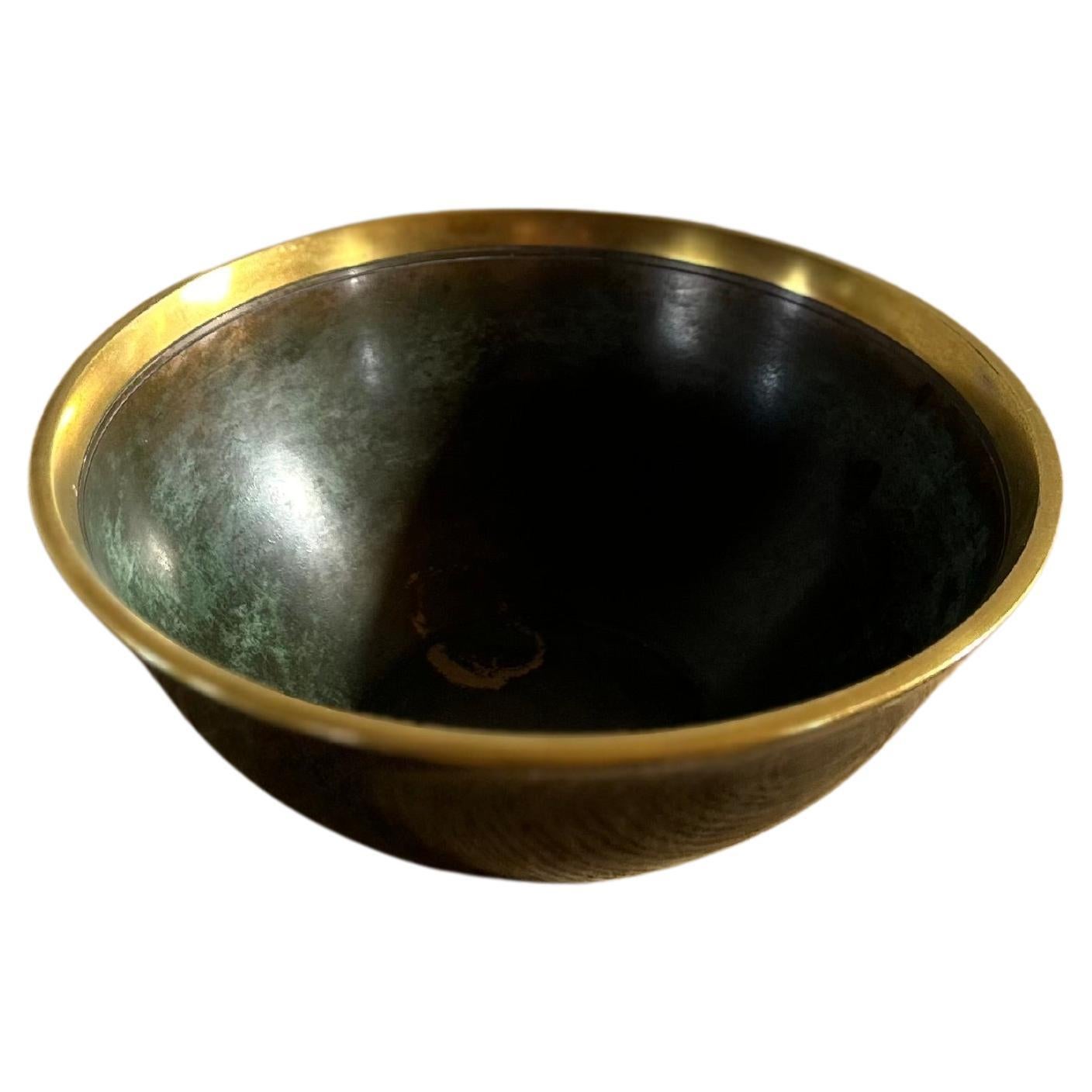Items Similar to Just Andersen Art Deco Light Bronze Dish Denmark 1930s
Want more images or videos?
Request additional images or videos from the seller
1 of 8
Just Andersen Art Deco Light Bronze Dish Denmark 1930s
About the Item
Just Andersen Art Deco dish in beautiful patinaed light bronze made in Denmark in the 1930's.
This dish is the perfect piece as a decorative element but can also be used as a fruit or nut bowl or whatever else you could think of.
The dish is signed Just Andersen LB 1734.
Art Deco, short for the French Arts Décoratifs, and sometimes just called Deco, is a style of visual arts, architecture, and product design, that first appeared in France in the 1910s (just before World War I), and flourished in the United States and Europe during the 1920s and 1930s. Through styling and design of the exterior and interior of anything from large structures to small objects, including how people look (clothing, fashion and jewelry), Art Deco has influenced bridges, buildings (from skyscrapers to cinemas), ships, ocean liners, trains, cars, trucks, buses, furniture, and everyday objects like radios and vacuum cleaners.
It got its name after the 1925 Exposition internationale des arts décoratifs et industriels modernes (International Exhibition of Modern Decorative and Industrial Arts) held in Paris.
Art Deco combined modern styles with fine craftsmanship and rich materials. During its heyday, it represented luxury, glamour, exuberance, and faith in social and technological progress.
From its outset, Art Deco was influenced by the bold geometric forms of Cubism and the Vienna Secession; the bright colours of Fauvism and of the Ballets Russes; the updated craftsmanship of the furniture of the eras of Louis XVI and Louis Philippe I; and the exoticized styles of China, Japan, India, Persia, ancient Egypt and Maya art. It featured rare and expensive materials, such as ebony and ivory, and exquisite craftsmanship. The Empire State Building, Chrysler Building, and other skyscrapers of New York City built during the 1920s and 1930s are monuments to the style.
In the 1930s, during the Great Depression, Art Deco became more subdued. New materials arrived, including chrome plating, stainless steel and plastic. A sleeker form of the style, called Streamline Moderne, appeared in the 1930s, featuring curving forms and smooth, polished surfaces. Art Deco is one of the first truly international styles, but its dominance ended with the beginning of World War II and the rise of the strictly functional and unadorned styles of modern architecture and the International Style of architecture that followed.
This dish are the perfect detail for any interior from the modern Wabi Sabi style interior to a more traditional Scandinavian to a Art Deco interior, it will add a decorative element to the interior.
- Creator:Just Andersen (Maker, Designer)
- Dimensions:Height: 1.38 in (3.5 cm)Diameter: 12.41 in (31.5 cm)
- Style:Scandinavian Modern (Of the Period)
- Materials and Techniques:Bronze,Patinated
- Place of Origin:
- Period:
- Date of Manufacture:1930s
- Condition:Wear consistent with age and use. Minor fading.
- Seller Location:Valby, DK
- Reference Number:1stDibs: LU6559233712892
About the Seller
5.0
Vetted Seller
These experienced sellers undergo a comprehensive evaluation by our team of in-house experts.
1stDibs seller since 2022
25 sales on 1stDibs
Typical response time: <1 hour
- ShippingRetrieving quote...Ships From: Valby, Denmark
- Return PolicyA return for this item may be initiated within 2 days of delivery.
More From This SellerView All
- Just Andersen Art Deco Solid Bronze bowl model B161, Denmark 1930’sBy Just AndersenLocated in Valby, 84Discover a piece of Danish design history with this exquisite vintage solid bronze bowl, model B161, crafted by the iconic artist Just Andersen in the 1930s. This stunning bowl epito...Category
Vintage 1930s Danish Scandinavian Modern Decorative Bowls
MaterialsBronze
- Evan Jensen Bronze Dish, Denmark, 1930sBy Evan JensenLocated in Valby, 84Bronze Art deco dish/charger by Danish artist Evan Jensen from the 1930's in a beautiful original condition, the dish is signed Evan Jensen Copenhagen Bronze and has model number 320. The dish has a very decorative image of a deer on the front. The dish is the perfect dish to have standing as a piece of art but can also be used as a bowl to store stuff like fruit or nuts or whatever else you could think of. Art Deco, short for the French Arts Décoratifs, and sometimes just called Deco, is a style of visual arts, architecture, and product design, that first appeared in France in the 1910s (just before World War I), and flourished in the United States and Europe during the 1920s and 1930s. Through styling and design of the exterior and interior of anything from large structures to small objects, including how people look (clothing, fashion and jewelry), Art Deco has influenced bridges, buildings (from skyscrapers to cinemas), ships, ocean liners, trains, cars, trucks, buses, furniture, and everyday objects like radios and vacuum cleaners. It got its name after the 1925 Exposition internationale des arts décoratifs et industriels modernes (International Exhibition of Modern Decorative and Industrial Arts) held in Paris. Art Deco combined modern styles with fine craftsmanship and rich materials. During its heyday, it represented luxury, glamour, exuberance, and faith in social and technological progress. From its outset, Art Deco was influenced by the bold geometric forms of Cubism and the Vienna Secession; the bright colours of Fauvism and of the Ballets Russes; the updated craftsmanship of the furniture of the eras of Louis XVI and Louis Philippe I; and the exoticized styles of China, Japan, India, Persia, ancient Egypt and Maya art. It featured rare and expensive materials, such as ebony and ivory, and exquisite craftsmanship. The Empire State Building, Chrysler Building, and other skyscrapers of New York City built during the 1920s and 1930s are monuments to the style. In the 1930s, during the Great Depression, Art Deco became more subdued. New materials arrived, including chrome plating, stainless steel and plastic. A sleeker form of the style, called Streamline Moderne, appeared in the 1930s, featuring curving forms and smooth, polished surfaces. Art Deco is one of the first truly international styles, but its dominance ended with the beginning of World War II and the rise of the strictly functional and unadorned styles of modern architecture and the International Style of architecture that followed. This dish is the perfect detail for any interior from the modern Wabi Sabi style...Category
Vintage 1930s Danish Scandinavian Modern Decorative Dishes and Vide-Poche
MaterialsBronze
- Agentor Art Deco Bronze tray Denmark 1930sLocated in Valby, 84Beautiful patinaed Art Deco Bronze dish by danish manufacture Agentor from the 1930's. The Dish has the motive of a woman running with her hunting dog next to her. This dish is the perfect piece as a decorative element but can also be used as a fruit or nut bowl or whatever else you could think of. The dish is signed Agentor Bronce number 47. Art Deco, short for the French Arts Décoratifs, and sometimes just called Deco, is a style of visual arts, architecture, and product design, that first appeared in France in the 1910s (just before World War I), and flourished in the United States and Europe during the 1920s and 1930s. Through styling and design of the exterior and interior of anything from large structures to small objects, including how people look (clothing, fashion and jewelry), Art Deco has influenced bridges, buildings (from skyscrapers to cinemas), ships, ocean liners, trains, cars, trucks, buses, furniture, and everyday objects like radios and vacuum cleaners. It got its name after the 1925 Exposition internationale des arts décoratifs et industriels modernes (International Exhibition of Modern Decorative and Industrial Arts) held in Paris. Art Deco combined modern styles with fine craftsmanship and rich materials. During its heyday, it represented luxury, glamour, exuberance, and faith in social and technological progress. From its outset, Art Deco was influenced by the bold geometric forms of Cubism and the Vienna Secession; the bright colours of Fauvism and of the Ballets Russes; the updated craftsmanship of the furniture of the eras of Louis XVI and Louis Philippe I; and the exoticized styles of China, Japan, India, Persia, ancient Egypt and Maya art. It featured rare and expensive materials, such as ebony and ivory, and exquisite craftsmanship. The Empire State Building, Chrysler Building, and other skyscrapers of New York City built during the 1920s and 1930s are monuments to the style. In the 1930s, during the Great Depression, Art Deco became more subdued. New materials arrived, including chrome plating, stainless steel and plastic. A sleeker form of the style, called Streamline Moderne, appeared in the 1930s, featuring curving forms and smooth, polished surfaces. Art Deco is one of the first truly international styles, but its dominance ended with the beginning of World War II and the rise of the strictly functional and unadorned styles of modern architecture and the International Style of architecture that followed. This dish are the perfect detail for any interior from the modern Wabi Sabi style...Category
Vintage 1930s Danish Art Deco Decorative Dishes and Vide-Poche
MaterialsBronze
- Just Andersen Art Deco Bronze Vase Model B2368By Just AndersenLocated in Valby, 84Rare and important Just Andersen Bronze vase model B2368. The vase is in good condition with a beautiful patina which has gotten even better over the years. This vase is a perfect piece for any interior and will fit any type of interior from the traditional Scandinavian style to a more Art Deco interior. Just Andersen (born 13 July 1884 in Godhavn, Greenland, died 11 December 1943 in Glostrup) was a Danish corpus artist, silversmith and sculptor and, together with his 1st wife Alba Just Andersen, founder of the world-renowned company Just Andersen A/S. Just Andersen was born in Godhavn on Diskoøen, located on the west coast of Greenland. His parents were inspector and probate administrator in North Greenland, Niels Alfred Andersen...Category
Vintage 1930s Danish Art Deco Vases
MaterialsBronze
- Just Andersen Art Deco Disko Metal Table Lamp Model D8, Denmark 1920’sBy Just AndersenLocated in Valby, 84Rare and tall Just Andersen Disko metal table lamp, Model D8. Standing at an impressive height of 72 cm (without the shade), this lamp is a testament to the elegance and sophisticati...Category
Vintage 1920s Danish Scandinavian Modern Table Lamps
MaterialsMetal
- Big decorative art deco bronze urn Denmark 1930’sBy Just AndersenLocated in Valby, 84Rare big Art Deco decorative patinaed alloyed bronze urn made by a skilled craftsman in Denmark in the late 1930’s. The urn is the perfect piece for your favorite flowers or bunch o...Category
Vintage 1930s Danish Art Deco Urns
MaterialsBronze
You May Also Like
- Just Andersen Art Deco bowl, 1930s, DenmarkBy Just AndersenLocated in Værløse, DKA Just Andersen art deco bowl in organic shapes and great vintage condition. * A curvy metal bowl * Designer: Just Andersen * Model: D1430 * Year: 1930s * Condition: Very good v...Category
Vintage 1930s Danish Art Deco Decorative Bowls
MaterialsMetal
- Set of Just Andersen bronze bowls, 1930s, DenmarkBy Just AndersenLocated in Værløse, DKA fine set of plate and bowl designed by Just Andersen in the 1930s. * A plate and bowl on foot in light-bronze alloy * Designer: Just Andersen * Model: LB1598 & LB1387 * Year: 19...Category
Vintage 1930s Danish Decorative Bowls
MaterialsBronze
- Art Deco Pewter Bowl by Just Andersen, 1930sBy Just AndersenLocated in Esbjerg, DKA rare pewter bowl or ashtray with architecturally styled ribbings. Designed and manufactured by Just Andersen in Denmark during the 1930s. Imprinted to its base: Just, Danmark, 2350...Category
Vintage 1930s Danish Art Deco Decorative Bowls
MaterialsPewter
- Just Andersen, Denmark 1930s Art Deco Pewter Squirrel Vide Poche #8291By Just AndersenLocated in Rothley, LeicestershireJust Andersen, Denmark 1930s Art Deco pewter stylised squirrel vide poche Circa 1930's Stamped and numbered 8291 on base Diameter 7 inch, Height 2.5 inch Remarkably good conditio...Category
Vintage 1930s Danish Art Deco Decorative Dishes and Vide-Poche
MaterialsPewter
- Just Andersen, Denmark 1930s Art Deco Pewter Squirrel Vide Poche #829By Just AndersenLocated in Rothley, LeicestershireJust Andersen, Denmark 1930s Art Deco pewter stylised squirrel vide poche Circa 1930's Stamped and numbered 829 on base Diameter 7 inch, Height 2.5 inch Remarkably good condition and...Category
Vintage 1930s Danish Art Deco Decorative Dishes and Vide-Poche
MaterialsPewter
- Just Andersen, Denmark 1930s Pewter Art Deco Woman Bathing Vide Poche #829CBy Just AndersenLocated in Rothley, LeicestershireJust Andersen, of Denmark 1930s pewter Art Deco vide poche The central figure of a kneeling woman bathing has superb detail and patina Circa 193...Category
Vintage 1930s Danish Art Deco Decorative Dishes and Vide-Poche
MaterialsPewter
